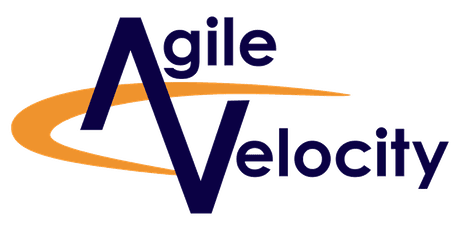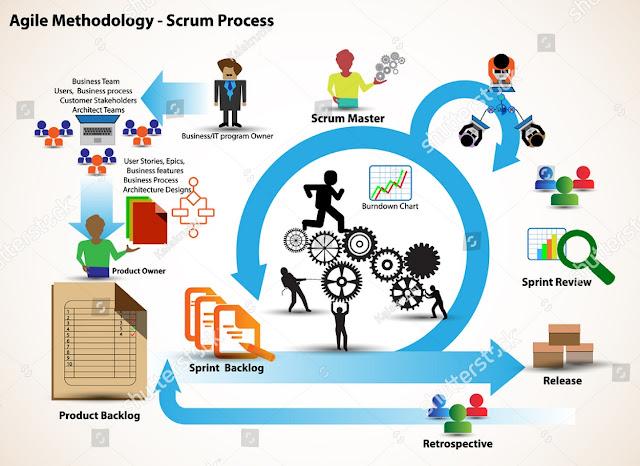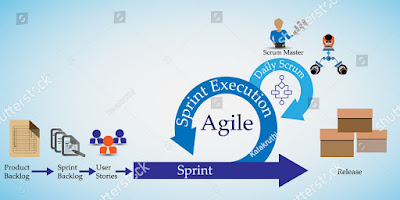All those belonging to the industry are very well aware of
the term “Scrum Master” as well as
their responsibilities. There are different hard and soft skills required to
become a Scrum Master. However, there’s
still a question: What’s the role of a Scrum
Master Advanced Training?
How’s the entire work day of a Scrum Master is like? How
does their day change while engaging with more teams? Let’s take a look in the working day of a
Scrum Master.
The Day Of A Scrum
Master:
After taking the
Scrum Master Advanced Training from any of the well-known institutes such as
Lean
Agile Training, you might be
wondering what work these
Scrum Masters
actually do.
The answer to this question
is here.
Responsibility of A Scrum
Master:
Mr. SM was a Scrum Master in a well-known organization. His
daily routine consisted of delivering value by removing hassles. This makes the
progress systematic. Experts in the
industry define Scrum Masters as “an individual who believes in power and
abilities of the people as well as its team”.
The entire work is to boost the team and prepare them for
their long term success. Hence, the main
task of Scrum Masters like Mr. SM is to work the entire day with the teams,
take them to a treat, etc. It is training with fun.
Some Other Examples
Of How They Lead The Team Is:
Ensuring that the process is accurate for the team to
work:
Good workers need systems like
Scrum to enhance their efficiency.
Scrum
masters work together with the team to find a proper solution for the problem
in
Certified Scrum Toronto.
This doesn’t mean that the final answer must be Scrum. To
mix it up; instead of waiting for a planned Sprint Review or a team creating an
experiment driven learning.
Team Protection: Scrum Masters become masters after
successfully completing the Scrum Master
Advanced Training and then they protect the team by protecting stakeholders
and make them understand the new way of working. The agile is completely different. Team empowerment is present and there’s no
need of any manager to delegate the tasks.
Here, project planning is extremely different.
The reason is focus shifts from the plan to the result. Instead of interacting with team members, the
leaders work directly with the Project Owners to prioritize the project. This change in shift takes time.
It is Scrum Master’s task to keep on educating stakeholders
to elevate the new terrain.
Arranging Scrum Ceremonies:
Like Mr. SM, there are many Scrum Masters who arrange for a timely
meeting known as Scrum Ceremonies for their team members to make them aware of
the project goals and ensure that the team is working on the track.
The scrum master must be prepared for the meeting by having
the foresight to identify the potential issues that are to be discussed in the
meeting. They must also be aware of the activities to be conducted for the team
to address the current issues then offering them the guidance to find an
appropriate solution.
Here, we have discussed just a few tasks that a Scrum Master
has to do. Hence, if you take the Scrum
Master Advanced Training, make sure first you understand the role of a
Scrum Master properly and then dig deep into the field only if you feel you can
wholeheartedly carry out the job.
Professional Scrum
Master: (PSM I) evaluation is also available for anyone who wants to confirm
the depth of the knowledge of the picturesque framework and its application.
Those who pass the evaluation will receive industry-approved PSM I Scrum Master Advanced Training and certification,
which will show their original level of Scrum Mastery.
It is not necessary to take a course and if you think that
you already have a high level scrumptious knowledge, how to understand the
scrum guide and how to apply the scrum within the chronic teams, you have the
option of taking a straight PSM is. However, such courses are available that
help you prepare for evaluation and gain a strong understanding of the scrum. Depending
on your role, either the 2-day Professional Scrum Foundation or the
Professional Scrum Master Advanced
Training and Course is highly recommended.
Prepare for
Assessment
Assessment is difficult; Preparation is necessary to achieve
the passing score. Reading the scrum guide and taking an open assessment alone
is not usually sufficient and we recommend reviewing the content below:
- Assessments include topics of many focus areas defined by
professional focus competencies.
- Many questions ask you to think or interpret meaning from
the scrum guide and how you implement the scrum within a scrum team.
- The PSM I suggest reading lists the focus areas that can be
selected during the assessment in Scrum
Master Advanced Training.
- There are several additional resources to help you prepare
for the PSM I assessment in the Scrum Master Learning Path.
- Find a list of existing business Agile Scrum Master Certification holders here or see a
breakdown on how many people hold the certificate.
- Stay tuned with us for more such informative blogs about
Scrum and Agile.
Tips to Become the
Scrum Master Your Team
As a scram master, do you ever feel like you are not doing
all this for your team? Are you doing the basics of the job, yet do you think
you can do more?
This is a very important question. Each of us has blind
spots which prevent us from seeing some things which we can do to better our
teams.
In my work with great Scrum
Master Advanced Training, and people who may not be great yet, but are
working to get there, I have identified eight things that often remind people
to become a Scrum Masters. The teams
which require are required.
Keep Calm First:
Embrace the effectiveness of all important pausing, the
ability to silence. When you are tempted to speak, then wait for others in that
awkward situation for others who follows a complex question or thought
provocative comment. You do not need all the answers.
And when you are calming yourself mentally, remember to
actively listen. Before the team member speaks, oppose the temptation to make a
mental answer. Instead, while someone else is talking, give your thoughts to
your thoughts. When they are finished, think before answering. There is nothing
wrong in keeping quiet while deciding how to respond.
Believe me when I say that to become a fully autonomously,
self-organizing team, your team needs your silent comments, so your silence is
more than that.
Feed Your Inner
Responsibility To Junkie
However, a Scram does not take responsibility for the
success of the Master Project - but this fee remains with the team - a scrum
takes the responsibility of the team to adopt and practice the scheme.
I often compare the Scrum
Master Advanced Training and the Scrum Master role of an orchestra
conductor. Both should provide real time guidance and leadership to the
talented collection of those people who come together to make something which
none of them can make alone.
Or as the Boston Pope's conductor Keith Lockhart says,
"People believe that when you become a conductor, you join a Napoleon
cheese - you want to stand on that big box and erase your power. I am not a
power junkie, I'm a responsible person. "
So to make your team a scram master according to your team's
needs, the second suggestion is that you feed junk to your inner
responsibility. Your responsibility is to make team members best. And one part
of doing this is to become the best you can be.
Master In The Art Of Checking
Third, the Scrum Masters should be aware of what is
happening with the team without crossing the line in the micromanagement. To do
this, they should be able to check without feeling it that they are checking.
While checking and checking may seem similar, they are
actually quite different. Scrum Master
Advanced Training and Scrum Masters who do not just ask about progress; they
provide real support in removing any obstruction or distraction that is
interrupting that progress. They avoid incriminating persons at all costs. And,
perhaps, most importantly, they ensure that the problem is given to the team to
give full autonomy to the team.
Investigating is very different. When you check a person,
you look like a plan - did the programmer finish the changes last night as he
had said? Did the tester automate the tests as promised or run it manually
"once more"?
Checking about status-type information is being
investigated. No problem. But to further include the offer to help in the
removal of any obstacle from progress, to include the offer.
To be a scrum master like your team, need and practice to
check the art of unchecked.
Show To The Team
When their teams look good, the Scrum Masters look good. As
such, they do whatever they need to help the team achieve their goals. And when
the team achieves something extraordinary, great screen masters ensure that all
people in the organization pay attention in Scrum Master Advanced Training.
Good Scrum Masters
also help their teams celebrate their success. There is no need to do
festivities on a large scale. You do not need to play Rolling Stones in your
retrospective. (But if you do, please invite me, please.)
Food is always a great way to celebrate. I brought bagel,
homemade cookies (yes, I can cook), or everyone's personal favorite morning
drink. The afternoon time is very good to go together in movies. I once bowled
a team, which was an explosion because the street showed the speed of each
ball. We paid more attention to the fact that the number of pins knocked on.
You helped the team to achieve their success. And it is very
important but they have achieved it. Make sure that they and others - recognize
that fact and respect it.















